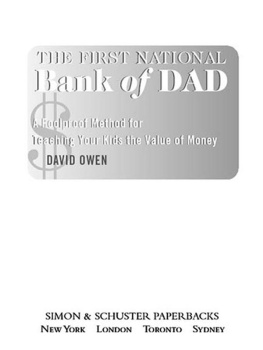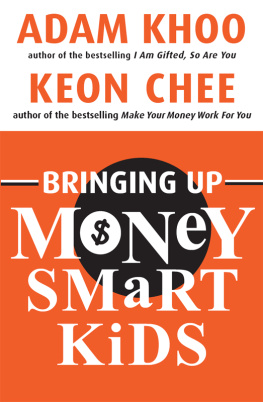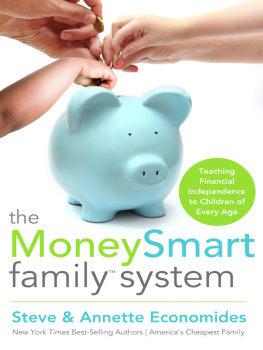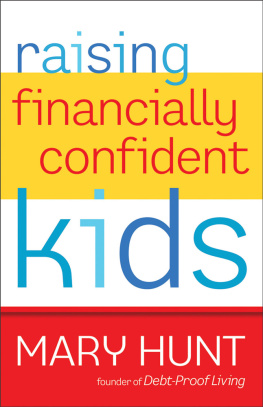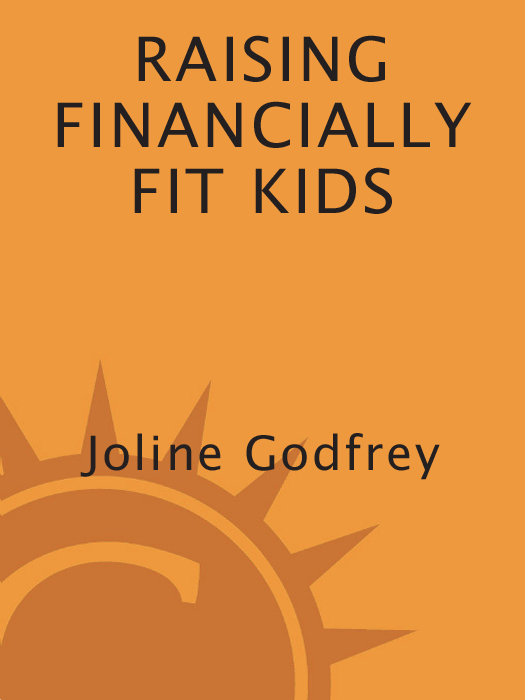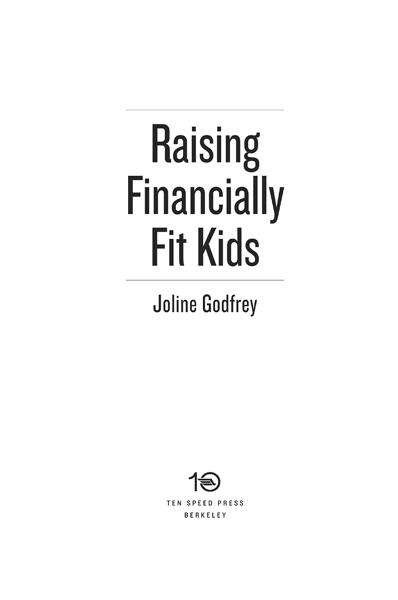Text copyright 2003 by Joline Godfrey
All rights reserved. Published in the United States by Ten Speed Press, an imprint of the Crown Publishing Group, a division of Random House, Inc., New York.
www.crownpublishing.com
www.tenspeed.com
Ten Speed Press and the Ten Speed Press colophon are registered trademarks of Random House, Inc.
Library of Congress Cataloging-in-Publication Data
Godfrey, Joline.
Raising financially fit kids / Joline Godfrey
p. cm
1. ChildrenFinance, Personal. 2. TeenagersFinance, Personal.
3. Saving and Investment. 4. Child rearing. I. Title.
HG179.G627 2003
332.024054dc21
2003056416
eISBN: 978-0-307-79050-7
Photography by Jock McDonald
Developmental editing and copyediting by Melissa Stein
v3.1
To Inabeth Millereducator, visionary.
Who, as a mentor, consistently made just one request:
Dazzle me, she would say. And those of us who
were in the circle of her wise counsel would reach higher,
stretch farther, push closer to the edge to
meet her challenges to us. Her spirit soars.

Introduction
Its Not Just About Money
Part One
Getting Started
Part Two
The Financial Apprenticeship
Part Three
Side Trips
Part Four
Map Check

Grace
A n author enjoys the privilege of writing (and the agony as wellit is so satisfyingly difficult, I sometimes liken it to digging a trench with a shovel) because a cast of friends, colleagues, and smart people make the effort feasible.
This book is written in my voice and is a gathering of the things I have learned and uncovered while working with thousands of kids and parents over the last decade. It also echoes a team of people who have worked collaboratively with me for many years to experiment with, create, and design a new way to engage kids in their own financial development. Without the commitment of this gifted group of people, including Lynn Karlson, Barbara Dowd, Valjeanne Estes, Betsy Steiner, Jan Seufert, Michele Massman, Steve Simon, Christina Woo, Judie Framan, and Penny Paine, the book would not have come to fruition. The endless hours they dedicated to working directly with the next generation, their days spent searching for ever-more-effective and original solutions to old and universal challenges, have made my own knowledge deeper and wider. Together we have pursued a dream. Their strength and resourcefulness in the journey fortify me.
In addition, this book has a treasured cadre of advisors, colleagues, and supporters to whom I owe gratitude and tribute:
Kit Hinrichs, hero, inspiration, design genius (hell blush), champion, and dear, dear friend, without whom this book literally would not exist.
Laura Scott, whose gift of realizing the vision of others is amazing; and Jon Schleuning, who is always right about everything!
Eva Miranda, whose vision for the book preceded my own and who simply would not let go of the refrain You have to write this book.
Betsy Amster, an agent for excellence who always makes me better than I start out to be, and Kirsty Melville, a writers publisher who grokked this book and was both advocate and contributor to the final vision. My real appreciation too to Windy Ferges and Melissa Stein, who were good-humored, patient, and instructive with me at every turn.
Melinda Little, who, with generous spirit of heart, shouldered even more responsibility than usual to make it possible for me to write this book.
Brooke Espinoza, Dia Rao, Kimberley Clouse, and Sarah Harden, whose insights and recollections added texture to my Persian carpet.
Joan Peters and Peter Passell, Carol and David Malnick, and Linda Hill and Roger Breitbart, whose love, support (material and psychic), intellect, and welcoming homes nourished (in a very real way) every page of this book.
Agnes Bourne, Fredi Stevenson, and Mary OConnell, who each taught, encouraged, and cheered me with their wisdom and rich experience, and with whom I hope to have a great celebratory dinner.
Professor Howard Stevenson of the Harvard Business School, whose own work informed mine and who generously opened doors that would have otherwise remained closed.
W. Bruce Cameron, writer/humorist exemplar, who inspired my thinking on how to raise financially fit kids far more than the Wall Street Journal did.
Penny Stallings, comedienne/writer, who added wit and perspective when it was most needed.
James OToole, whose encouragement of my voice matters deeply to meand whose comments on the book helped make that voice stronger.
Like my previous work, this book is built on the lives of real people. To the parents and children who taught me anything I know and have shared in these pages, a note of grace: From you came the simple lessons of raising financially fit kids embodied in these old, old words from Ecclesiastes: a time to seek and a time to lose; a time to keep and a time to cast away; a time to rend and a time to sow
To you all, my love and thanks.

Foreword
Y ears before Alan Greenspan said Improving basic financial education at the elementary and secondary school level can provide a foundation for financial literacy, helping younger people avoid poor decisions that can take years to overcome, Joline Godfrey was providing financial education to thousands of young adults. For over a decade, she has conducted hundreds of financial education workshops and summer camps for teens; in the process she realized that financial literacy is not just an issue for kids, but a family issue.
Broad economic forces, political shifts, personal needs, and societal pressures have now converged to create a world in which each of us has a personal responsibility to learn about and actively manage our financial livesand to be conscious about the consequences of the financial decisions we make. Parents who have the financial bruises of the dot-com boom and bust; the loss in value of stocks and options, jobs, and insolvent corporate retirement plans; and mounting credit card debt, now want their kids to be armed with the protection of financial literacy. Fortunately the tools to make this possible are now more readily accessible. Raising Financially Fit Kids is just such an aid.
While the importance of financial literacy as a basic life skill has become obvious to educators and policymakers, how to develop this skill has remained a challenge. Schools, already struggling with insufficient resources to deal with a plethora of societal imperatives, simply arent able to add one more life skill to the core curriculum. And parents, lacking confidence in their own financial literacy, often feel that the best they can do for their kids is to exhort them to save and to not spend so much money.



